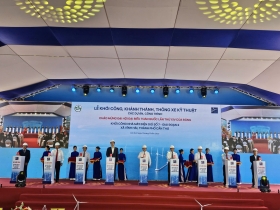Vietnam: Government is aming for the renewable energy
15/11/2019
Since the end of 2015, the Government of Vietnam has issued Decision No. 2068 / QD-TTg with the goal: "Reduce greenhouse gas emissions in energy activities compared to the normal development plan".
Since then, the government has approved the Renewable Energy Development Strategy (RE) of Vietnam to 2030, with a vision to 2030. Specifically, the contribution rate of RE sources is as follows: “About 5% of 2020; around 25% in 2030 and about 45% in 2050 ”.
According to many experts, if Vietnam is determined to act, it is possible to achieve the above-mentioned goal, because our country has converged on favorable natural conditions for developing the most important forms of clean electricity.
Natural conditions: Great potential
Compared with many countries, Vietnam has many advantages to strongly develop the renewable energy industry. Because, we have huge natural potential for various renewable energy sources widely distributed across the country.
According to many experts, if Vietnam is determined to act, it is possible to achieve the above-mentioned goal, because our country has converged on favorable natural conditions for developing the most important forms of clean electricity.
Natural conditions: Great potential
Compared with many countries, Vietnam has many advantages to strongly develop the renewable energy industry. Because, we have huge natural potential for various renewable energy sources widely distributed across the country.
.jpg)
Indeed, solar energy in Vietnam is distributed across the country and is abundant with an average solar radiation of 5kWh / m2 / day. According to data from the Ministry of Industry and Trade, each year Vietnam has about 2,000-2,500 hours of sunshine with an average sunshine of about 150kCal / cm2, equivalent to the potential of about 43.9 million tons of oil equivalent / year.
Besides, wind energy is also quite abundant with about 3400 km of coastline. According to controls, the potential of producing electricity from wind power can reach 24GW. In detail, on land, the total wind power capacity can reach about 800-1,400 kwh / m2 / year. Capacity in coastal areas; The Central Highlands and the South can reach about 500-1,000 kwh / m2 / year, while in other areas less than 500 kwh / m2 / year.
Lower than the above-mentioned types of energy, but the equivalent biomass energy is about 43-46 million tons of oil, of which 60% comes from wood waste and 4% comes from agricultural waste. In addition, biomass from agricultural products or waste produces an equivalent of 10 million tons of oil per year. The potential of biogas is approximately 10 billion m3 per year that can be collected from garbage, animal manure and agricultural waste.
Geothermal energy is also notable. Particularly for the Red River Delta region, which is limited in wind and solar energy sources due to climate factors, studies show that geothermal energy is quite positive with many geothermal basins in the Southeast - Northwest, Geothermal fracture of Lo River - Vinh Ninh ...
In addition, there is a source of biomass from agricultural products or wastes with an output of 10 million tons of oil / year. The potential of biogas is approximately 10 billion m3 per year that can be collected from garbage, animal manure and agricultural waste.
And finally, the role of small hydroelectricity (with a capacity of less than 30MW) should not be neglected with a total capacity of more than 4000MW ...
Government policies
From 2011, a National Power Development Plan for the period of 2011-2020 has a vision to 2030; called Power Planning VII, was issued. After 5 years of operation, that Planning has proved no longer appropriate to the developments of the actual situation of the country and the world. On the other hand, the trend against greenhouse gas emissions is also warming the atmosphere of the Earth.
Therefore, at the end of 2015, the government issued a new project to adjust the national electricity development plan for the period of 2011-2020 with a vision to 2030; called Revised Power Planning VII.
According to the 7th Master Plan, the goal for 2020 is to produce electricity from renewable energy (RE) accounting for 38% of the national electricity output, including large and medium hydroelectricity (101/265 TWh); by 2030, accounting for 32% (186/572 TWh).
Proportion of renewable energy sources has not been able to keep up, affecting the safety of electricity supply, the Revised Electricity Master Plan has proposed that the target of RE power production in 2020 will account for a lower proportion, only about 32% (i.e. the absolute value is only 84.1 TWh, of which small hydroelectricity, wind power, solar power, biomass power ... is 17.3 TWh) and RE production in 2030 is only 23.1 % (i.e. the absolute value is only 131 TWh, of which small hydroelectricity, wind power, solar power, biomass electricity ... is about 60.9 TWh).
The plan also projects the capacity of all types of electricity to be developed by 2020 and 2030 as follows:
Geothermal energy is also notable. Particularly for the Red River Delta region, which is limited in wind and solar energy sources due to climate factors, studies show that geothermal energy is quite positive with many geothermal basins in the Southeast - Northwest, Geothermal fracture of Lo River - Vinh Ninh ...
In addition, there is a source of biomass from agricultural products or wastes with an output of 10 million tons of oil / year. The potential of biogas is approximately 10 billion m3 per year that can be collected from garbage, animal manure and agricultural waste.
And finally, the role of small hydroelectricity (with a capacity of less than 30MW) should not be neglected with a total capacity of more than 4000MW ...
Government policies
From 2011, a National Power Development Plan for the period of 2011-2020 has a vision to 2030; called Power Planning VII, was issued. After 5 years of operation, that Planning has proved no longer appropriate to the developments of the actual situation of the country and the world. On the other hand, the trend against greenhouse gas emissions is also warming the atmosphere of the Earth.
Therefore, at the end of 2015, the government issued a new project to adjust the national electricity development plan for the period of 2011-2020 with a vision to 2030; called Revised Power Planning VII.
According to the 7th Master Plan, the goal for 2020 is to produce electricity from renewable energy (RE) accounting for 38% of the national electricity output, including large and medium hydroelectricity (101/265 TWh); by 2030, accounting for 32% (186/572 TWh).
Proportion of renewable energy sources has not been able to keep up, affecting the safety of electricity supply, the Revised Electricity Master Plan has proposed that the target of RE power production in 2020 will account for a lower proportion, only about 32% (i.e. the absolute value is only 84.1 TWh, of which small hydroelectricity, wind power, solar power, biomass power ... is 17.3 TWh) and RE production in 2030 is only 23.1 % (i.e. the absolute value is only 131 TWh, of which small hydroelectricity, wind power, solar power, biomass electricity ... is about 60.9 TWh).
The plan also projects the capacity of all types of electricity to be developed by 2020 and 2030 as follows:
- Small hydroelectricity 3500 MW / 6000 MW
- Biomass, biochemical, geothermal electricity ... 940 MW / 3400 MW
- Wind power 710 MW / 6000 MW
- Solar power 850 MW / 11800MW
- Total resources of renewable energy sources 6004 MW (year 2020) / 27200 MW (year 2030)
Obviously, according to the revised Electricity Planning VII above, the total capacity of renewable energy sources by 2030 will increase by 4 times compared to the previous 10 years (2020). As a result, the exploitation of renewable energy will help Vietnam reduce its dependence on imported energy sources, ensure energy security for the country and at the same time reduce part of greenhouse gases harmful to people.
In addition to the set planning targets, the Government of Vietnam has issued many policies to encourage the development of renewable energy, set renewable energy targets and target a competitive electricity market with diversified investment sources and business models. In addition, the Government has added Vietnam's National Renewable Energy Development Strategy not only to 2020, 2030 but also a vision to 2050.
Realizing the above strategies, the Government has also been encouraging the development and use of new and renewable energies; provide financial support for pilot production research and development of preliminary models; Exempt import tax for production and circulation tax.
However, according to experts, the characteristic of renewable energy is that it depends heavily on natural conditions (water, sunshine, wind, geographic location ...), technology and production cost. Therefore, to promote the development of renewable energy, the government needs to support policies such as quota mechanism, fixed price mechanism, bidding mechanism and certification mechanism.
An important point that cannot be ignored is that, despite investing in the development of such renewable energy sources, after 15 years (2020), environmentally harmful thermoelectric sources still account for over 50%.
.jpg)
The distribution of our country's electricity sources in 2020 (wordpress.com)
This means that in order to have a healthy atmosphere for our country and for the Earth in general, investing in clean power sources is a big and long-term requirement. Of course, renewable energy sources alone cannot be replaced immediately, and the replacement process must take many decades longer. That is not to mention the price issue.
Meanwhile, nuclear power plants; Like renewable power plants, neither emissions of greenhouse gases nor nuclear power are considered clean electricity. Therefore, the government has included the plan to build the first nuclear power plants in Power VII and in the Revised Power Plan VII.
Clearly, the national policies to develop our country's electricity industry have been formed. The issue is responsibility to deploy. It is the responsibility of the ministries, branches and localities concerned and the highest is the Government.
Other articles
- Sigma Is Honored and Proud to Attend the Groundbreaking Ceremony of Phase 2 of the Soc Trang 7 Nearshore Wind Farm (19/12/2025)
- Sigma Spreads the Spirit of Compassion – Calling for Participation in the 5th “Red Sunday” Program 2026 (06/11/2025)
- Sigma Successfully Signs Contract for the Soc Trang 7 Nearshore Wind Farm Project (Phase II) (07/11/2025)
- Carbon Credits and the Carbon Market in Vietnam: Interesting facts that you may not know (28/05/2022)
- Sigma Engineering - Affirming capacity and experience in the field of wind power (30/12/2021)
Partners








































_thumbcr_130x97.png)























 Address :
Address :  Email :
Email :  Tel : (84-24) 3 9288683 | (84-24) 3 9289235
Tel : (84-24) 3 9288683 | (84-24) 3 9289235 Fax : (84-24) 3 9288667
Fax : (84-24) 3 9288667.png)
